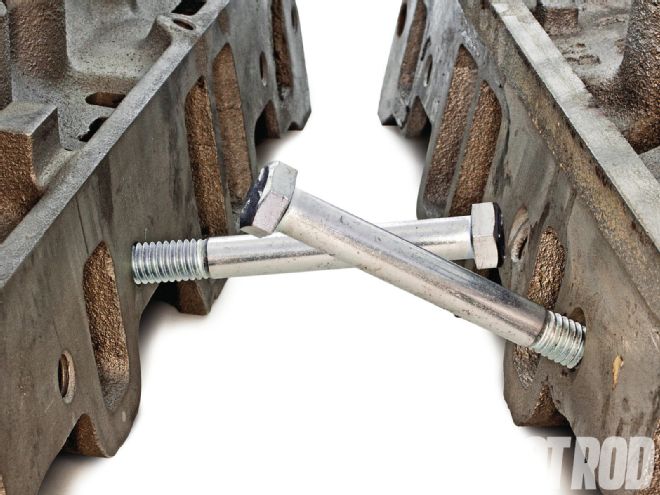
Wendell T. Brown From Kansas City, Missouri, Asks
Q: Will Late 350 Chevy TBI Heads Work on a Carbureted '70s Short-Block?
A: I have a '72 350 Chevy engine without the original heads. Can '90 350 throttle-body injection (TBI) heads off a 1500 Chevy truck work? Some engine shops told me yes, and some said no, because of the water jackets and that they are low-performance heads, anyway. My engine is bored 0.040-over with Sealed Power pistons with 10.0:1 compression. The engine is going in my '77 C10 pickup truck. It is just transportation, not for the dragstrip.
Wendell, your heads share similar characteristics with '87-'95 iron production small-block Chevy heads (not to be confused with '96-and-later Vortec heads or reverse-cooling '94-'96 Iron-headed Generation II small-blocks). These '87-'95 heads have the same water jackets as early heads and still retain a street-carburetor-friendly exhaust heat-riser passage, but there are other differences you need to be aware of. Tony Knight of Cylinder Head Exchange, a leading West Coast cylinder-head bank for just about any domestic or foreign head, helped set us straight. Current GM Part No. information was provided by Ken Casey of John Elway Chevrolet.
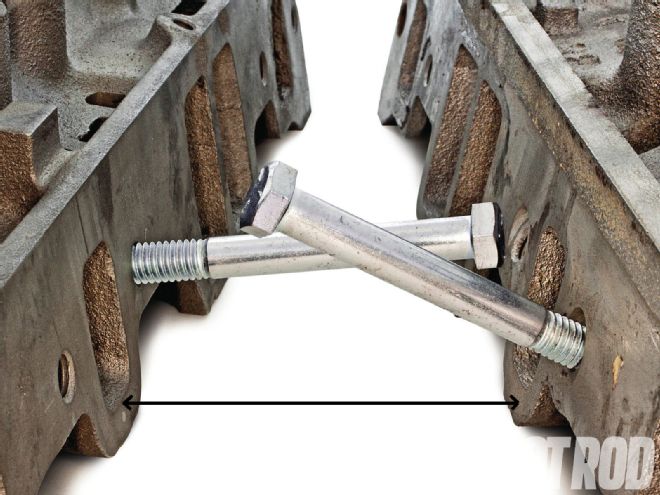 On ’55–’86 cast-iron heads (left), the intake attaching boltholes are perpendicular to the intake-gasket surface. The two center boltholes on ’87–’95 cast-iron heads (right) are angled at 72 degrees off the intake face. This requires a corresponding intake with the correct bolt-pattern. Both designs have heat-risers (arrows).
On ’55–’86 cast-iron heads (left), the intake attaching boltholes are perpendicular to the intake-gasket surface. The two center boltholes on ’87–’95 cast-iron heads (right) are angled at 72 degrees off the intake face. This requires a corresponding intake with the correct bolt-pattern. Both designs have heat-risers (arrows).
Regarding physical interchange: Yes, the heads in this group physically bolt on to your existing short-block but require a unique intake manifold and corresponding intake-gasket set because the center two intake-manifold-to-cylinder-head attaching bolts are drilled at a different angle than traditional small-block Chevy heads. Most GM production cars and trucks used TBI or (on some Camaros and Firebirds) TPI (tuned port injection) manifolds on this series of heads. However, there were still some carbureted applications in '87 and '88 that had factory intakes that accept a Quadrajet carburetor and are drilled with the new intake-to-head-bolt pattern. Casey says to look for Q-jet intakes on 305 LG4 (VIN-H) engines installed in the '87 Camaro/Firebird (F-chassis) and '87-'88 Monte Carlo (G-chassis), the 305-HO L69 (VIN-G) in the '87-'88 G-chassis, and the 350ci LM1 engines installed in '87-'88 fullsize Caprice Police cars (B-chassis with SEO 9C1 or 9C6). Most of these Q-jet intakes are iron (GM PN 14101075, discontinued; Hollander Salvage Yard Interchange No. 1161), but a rarer aluminum intake was also factory-installed on some of these cars.
At one time, GM offered a marine, cast-iron, dual-plane, high-rise intake dual-drilled for both Q-jet and square-flange carbs for sale through dealer parts departments (PN 14097494), but it was discontinued in February 2010. Edelbrock lists carbureted dual-drilled (Q-jet/square-flange) Performer aluminum intakes for '87-'95 cast-iron cylinder heads (PN 2104, without EGR; PN 3706, with EGR). Another commonly chosen option is to oblong the center four holes of a standard intake, ovaling them until the bolts fit, then using wedge-shaped washers under the bolt heads.
One potential deal-breaker is the possible effect of the late heads on your engine's compression ratio. The '87-'95 cast-iron 350 heads returned to 64-66cc combustion chambers. You state that your Sealed Power pistons are designed to produce 10.0:1 compression. If that's 10.0:1 with a 64cc head, assuming decent tuning skills, you should be OK on pump premium unleaded (cranking compression should not exceed 200 psi). However, if these pistons are, in fact, designed to yield a 10.0:1 ratio with the stock 75-76cc smog-chamber heads as originally factory-installed on the '72 350 short-block or on your '77 C10's old 350 engine, there will be big-time problems: The small chambers in the '90 heads raise the compression ratio 1 to 1.5 points. Depending on the piston deck height and head gasket, that could end up as high as 11.5:1-not viable on pump gas with old-school, non-electronically-controlled engines and mild, off-the-shelf cams.
Early heads have a six-bolt exhaust flange (A); around ’76–’77, a seventh hole (B) was added at one end that supports heavy catalytic converters (on the passenger side) or redesigned power-steering pump brackets (on the driver side). Stock exhaust manifolds must match (headers often have both patterns). The ’70s-era heads have a ½-NPT temp-sender boss (C); later use a 3⁄8-NPT boss (D). On early “heavyweight” heads, the deck surface below the outer row of head-bolt bosses is straight (E). Later “lightweight” heads like Brown’s castings have scallops (F). Lightweights have thin decks that usually can’t be milled and shouldn’t be installed using steel-shim head gaskets. Late heads add exhaust wire-loom mounts (G).
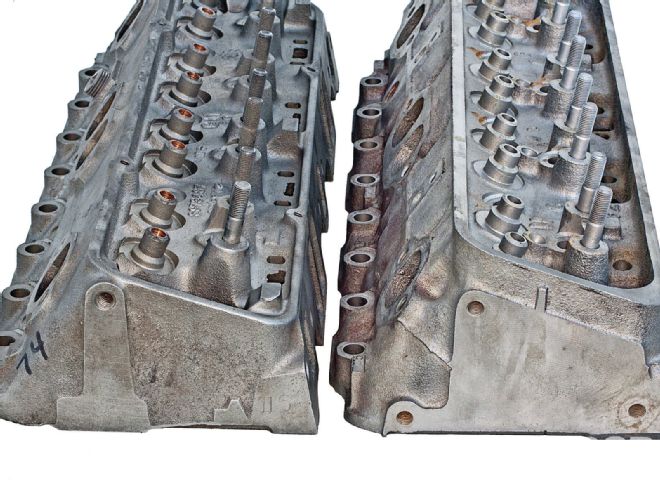
Most late-’60s through mid-’80s heads have one accessory mount bolthole at one end (left) and three holes at the opposite end. Starting in the mid-’80s, both ends have had all three holes (right). In terms of accessory-mounting provisions, late heads work with early brackets, but early heads may not accommodate late brackets (including some serpentine-drive setups).
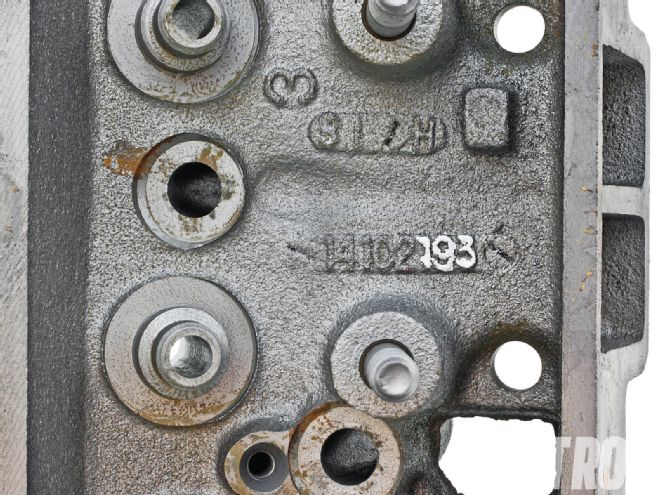
ID Chevy heads by the casting number’s last three digits. The full number is cast on the valve-cover side (shown); the last three digits are repeated on the chamber side at the bottom of an intake runner. Brown’s ’90 1⁄2-ton truck heads should be a No. 193 casting like this. Three-quarter-ton heads had No. 191 castings; 1-ton used No. 810. Caution: 810s had valve rotators with a deeper valvespring pocket and must be heavily shimmed when using normal springs without the rotators.
Different rocker arms may be required. Heads not set up from the factory for close-tolerance pushrod guideplates had oblong pushrod guide slots broached on the valley side of the heads until about 1990, and originally used nonguided, "flat-pallet," rocker arms. After that, GM began transitioning to a new, guided rocker-arm design with a U-shaped pallet. Heads for guided rockers have large, 716-inch, round pushrod holes. The relatively rare production GM heads factory-machined for screw-in studs and close-tolerance pushrod guideplates also had either big round holes drilled through the original oblong slots or large pushrod "windows." These differences are important, because with the wrong combo, the pushrod could potentially be put into bind from trying to locate in two different places. In terms of your late heads, Knight has seen the same casting number factory-machined both ways (with either slots or holes).
Officially, GM says guided rockers can replace the earlier nonguided design all the way back to '55 and should therefore work on any small-block head. However, the early nonguided rocker can't be used on late heads machined with the round, 716-inch, guided-rocker-style holes. Even so, in my opinion, you should also not use guided rockers with any mechanical lifter and/or heads with close-tolerance pushrod guideplates.
Most ’71 through mid-’80s iron production heads had large 76cc chambers, used to help drop compression for compatibility with unleaded gas before the advent of electronic engine management. Common castings in this group include Nos. 487, 624, or 882. Some of these even had 2.02/1.60 valves, screw-in rocker studs, and pushrod guideplates. The late ’80s marked a return to smaller, 64–65cc chambers. No. 193 is typical of most TBI ’87–’95 iron heads, with half the intake valve-bowl approach blocked off—not good for serious performance. One exception is the ’87–’91 Camaro TPI 350 No. 083 head that had full “open” intake runners. With old used heads, be sure that the spark-plug cooling “eyebrow” (arrows) hasn’t rotted out to the extent it impinges into the head gasket’s fire-ring bead area.
As with any '86-and-later Chevy small-block production casting, the '90 heads are machined for center-bolt valve covers instead of the perimeter-bolt covers used on older heads. If original appearance isn't a requirement, just use any of the myriad available stock or aftermarket center-bolt covers. In terms of maintaining the original appearance, Speedway Motors is one source for an adapter that allows the use of perimeter-bolt valve covers (PN 91017157).
Although you say the intended application is "just transportation," for the record and general knowledge of our readers, it is important to note that most '87-'95 cast-iron production heads have at best limited performance potential. Although the 350 versions do at least have 1.94/1.50-inch valves, nearly all variations have half the approach to the intake-valve bowl blocked off in a crude attempt to induce mixture swirl. With any decent cam, most castings in this series of heads will give up at 3,500-4,000 rpm. Knight says the main exceptions are the '87-'91 Camaro/Firebird 350-TPI head (casting No. 083, 64-65cc chamber, 1.94/1.50 valves) and its 305-TPI equivalent (casting No. 081, 55cc chamber, 1.84/1.50 valves)-both are nonswirl castings with standard-configuration intake runners. The '87-'88 Caprice carbureted 350 Police cars reportedly use nonswirl heads as well.
If performance is the main criteria, and excessively high compression with your existing pistons won't be a problem, when it comes to production iron castings, '96-and-later L31 Vortec heads (casting Nos. 062 or 906) are superior to any earlier factory design, even '60s muscle car-era heads. However, Vortec heads have additional interchange issues beyond the scope of this discussion.
If large-chamber (75-78cc) heads are needed to keep the compression ratio under control, you'd be better off with commonly available late '70s No. 882 castings. They're a direct replacement for your model year, with the right intake-manifold bolthole angles, combustion chamber size, valve-cover bolt pattern, and temperature sender hole. No. 487 castings are another good choice.
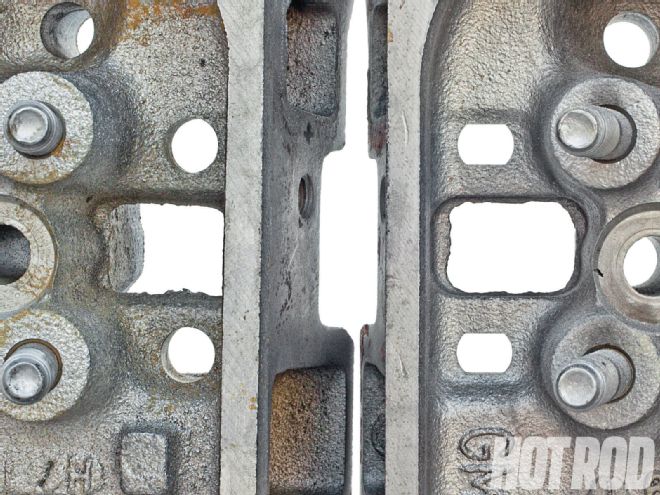
Large, round small-block Chevy cylinder-head pushrod guide holes (left) are for use with guided rocker arms; oblong slots (right) were originally used with nonguided rockers. Brown’s ’90 heads could have been factory-machined with either slots or holes. If the heads have the round holes, Brown needs to use guided rockers to properly locate the pushrods.